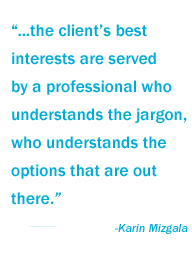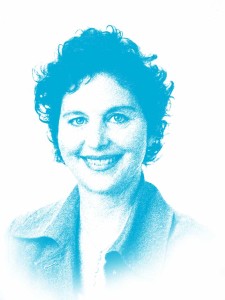Recently Women’s Financial Learning Centre and Money Coaches Canada co-founder Karin Mizgala sat down with Money Coach Noel D’Souza to discuss the changing landscape of financial advice in Canada.
Karin: As someone in the financial industry, it’s very common to be asked by people outside the industry, to explain the different fee structures of financial advice. So, Noel, let’s start with an overview of the common compensation models available to Canadians today.
Noel: The most prevalent model we see in the industry is the commission-based advice model, where an advisor sells products, typically mutual funds or some other investment product, they may also sell insurance, and they receive a sales commission for making the sale and also quite likely receive a trailing commission which is supposed to cover on-going advice and services. Usually the client never sees the commission fees, and we’ll be discussing how that may change in the future, but usually those fees are hidden within the cost structure of the product they are buying.
The second type is fee-based. An advisor will charge the client fees based on the size of the assets under management, a percentage of the total portfolio.
The third model, which is up and coming, is the model we work under; fee-for-service. Clients pay a fee directly and explicitly to the advisor for services rendered and it’s not tied to product sales, or size of assets, in any way.
Karin: So that will sound pretty straight forward to most people, why does it become murky, what are the implications for someone seeking financial advice? What are the benefits and shortcomings of each model?
Noel: Well I think a perceived benefit of the commission-based model is that there are no out of pocket costs to the client, making it accessible to all income and net worth levels. They never have to write a cheque, they never have to take out their wallet. It appears free so seems like a lower barrier to entry for receiving financial advice. However, in the experience of the clients I’ve spoken with, that advice is normally focussed around the investments, there is almost no advice around things like debt, maybe a little advice around taxes, and again that’s usually focussed on the investment aspect in terms of asset, where are they going to put the assets for the best tax savings. Little about estate planning other than filling in a beneficiary designation on their registered assets, not too much about banking, certainly not anything about spending or savings and how they are going to manage their cash flow. So advice may appear free, but is rarely comprehensive, so that’s a definite shortcoming.
In the fee-based model there is greater cost transparency because the client is paying a fee explicitly to the advisor, and advisor income is not directly tied to transactions, it’s strictly based on the portfolio size. Since the advisor is paid a percentage of assets managed, there is certainly a vested interest in the growth of the client’s portfolio, to the benefit of both. The shortcoming is that the advisor’s income is still tied to assets; they may require fairly sizable minimums so that the portfolio under management generates a sufficient amount of fees on a percentage basis to really make it worth their time. So this model has a higher barrier to entry as smaller accounts may not be wanted.
Both the commission-based and the percentage-fee model, really cater to investors, because the focus of advice is on investing and investment products, that’s the core of how the advisors make money.  So the question then arises, what about all those other areas of financial planning that aren’t directly related to investing – debt, cash flow, taxation, estate planning, insurance – how do those needs get served and do clients receive advice? And we haven’t even discussed the inherent conflict of interest of providing advice while selling products.
So the question then arises, what about all those other areas of financial planning that aren’t directly related to investing – debt, cash flow, taxation, estate planning, insurance – how do those needs get served and do clients receive advice? And we haven’t even discussed the inherent conflict of interest of providing advice while selling products.
Karin: Yes, I definitely want to discuss conflict of interest, but let’s first go over the benefits and shortcomings of our model, the fee-for-service financial planner or money coach.
Noel: Yes, for sure. In the fee-for service model the benefit is two-fold; you can trust that the advice isn’t tied to a vested interest in a commission and the advisors provide a much broader scope of advice than investment focussed advisors. There is discussion beyond retirement planning, that includes goals for next month and next year, advice and help is given for eliminating debt, and for managing cash flow in the here and now. It’s a much more comprehensive and inclusive form of financial planning.
 Karin: And yet there is the very real downside to our model. Clients pay us very direct, very tangible dollars out of their bank account, as opposed to even the percentage of assets fee based client, where the compensation for the advisor is actually coming out of the investment, not out of their household budget. So while clients may appreciate the unbiased nature and the comprehensive nature of what we do, if they are struggling with tcash flow, as most people are doing these days in our society, it becomes a difficult choice to make.
Karin: And yet there is the very real downside to our model. Clients pay us very direct, very tangible dollars out of their bank account, as opposed to even the percentage of assets fee based client, where the compensation for the advisor is actually coming out of the investment, not out of their household budget. So while clients may appreciate the unbiased nature and the comprehensive nature of what we do, if they are struggling with tcash flow, as most people are doing these days in our society, it becomes a difficult choice to make.
Noel: It does. But I would add to the benefit side that, one of the things clients often mention to me, is that in the other models they often feel like they are blindly following advice, they don’t really leave feeling more personally in charge of their finances, and that difference alone, the feeling of really understanding how their money can work for them and that what they do day-to-day matters, really changes their relationship with money.
Karin: And if clients want to invest, if they need insurance, even though we don’t sell products we can make the introductions, we can coordinate the implementation, we can vet other carriers of investments and financial products and insurance products, so that again, the client’s best interests are served by a professional who understands the jargon, who understands the options that are out there.
So, beyond the basics of each model, many of our readers may have heard of CRM2, which is short for Client Relationship Model 2, but can you explain briefly what the idea surrounding it is?
Noel: Very generally, financial industry regulators are putting in place some measures to increase the transparency of fees to further unveil the cost of investing and how much investors are paying. Previously the information may have been available if requested, but it didn’t necessarily have to appear in a client’s statements. Now there is going to be more light shone on how much exactly clients are paying in terms of actual dollars and cents on their investments. They are trying to make things more transparent.



HI Noel and Karin
Great article and explanation for clients. Our goal at Integral Financial Services is always to put the clients needs first and hopefully, we do provide value to our clients with our service. I like your point about designations and what they mean. We have chosen to be specialists in our company with each of us holding the appropriate designations for the products and services we represent. Tough to know it all these days so makes my life a lot easier when I can refer to a specialist within our company who can better meet the needs of the client. Also, great to have Money Coaches to refer to for full financial planning, debt and cash flow management.
Thanks for sharing.
Glennis Deslippe BSN, CHS, GBA
Living Benefits Specialist
Regards,
Glennis Deslippe